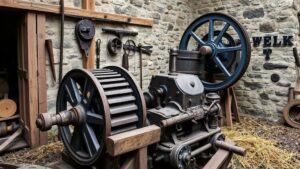Unearthing Coins and Tokens in Historic Entertainment Venues
Unearthing Coins and Tokens in Historic Entertainment Venues
The study of coins and tokens unearthed in historic entertainment venues offers a fascinating glimpse into the socioeconomic conditions, cultural practices, and technological advancements of past societies. These artifacts not only serve as currency but also as cultural indicators that reflect the values, trends, and everyday life of the period in which they were minted and utilized. This article delves into the significance of these findings, the methodologies employed in their discovery, and notable case studies.
The Historical Significance of Coins and Tokens
Coins and tokens have played a vital role in facilitating transactions throughout history, particularly in entertainment venues such as theaters, circuses, and amusement parks. Unlike regular currency, tokens often served specific purposes, such as granting access to rides or performances, indicating a temporary form of currency associated with a particular establishment. This specificity offers unique insights into consumer behavior and entertainment practices of the time.
For example, in the 19th century, many amusement parks, such as Coney Island in New York, issued their own tokens as a means of controlling access to attractions. These tokens often displayed the parks branding or imagery related to popular attractions, making them collectible items for visitors. Such practices not only reflect the commerce of the time but also the marketing strategies employed by venue operators to attract repeat visitors.
Methodologies for Uncovering Tokens and Coins
- Metal Detecting: This method is one of the most common in archaeological digs, especially in areas where historical events have taken place.
- Excavation: Systematic digging in targeted locations, such as beneath existing structures or in areas that show signs of activity, is vital.
- Historical Research: Before any physical exploration begins, researchers often delve into historical accounts to identify locations that might yield artifacts.
Utilizing a multi-faceted approach ensures a comprehensive understanding of the context in which these artifacts were used. For example, researchers might couple metal detecting with excavation strategies based on archival research, increasing the chances of locating significant items.
Case Studies of Historic Discoveries
Several case studies exemplify the profound significance of unearthing coins and tokens in entertainment venues. One notable example is the discovery at the site of the original Alhambra Theatre in Los Angeles. In the early 2000s, excavations revealed numerous tokens previously used in the venue, which date back to its opening in 1923. These tokens provided insights into the theaters ticketing practices and its popularity as a social gathering space during the roaring twenties.
Another significant case is the unearthing of coins at the site of the famous Blackpool Pleasure Beach in England. The tokens and coins found during routine maintenance in the mid-1990s have been instrumental in tracing the park’s evolution from a simple seaside resort to a full-fledged amusement park in the early 20th century. Such artifacts shed light on the changing nature of leisure and entertainment in an increasingly industrialized society.
Impact on Modern Collecting and Preservation
The unearthing of coins and tokens from historic venues has stimulated a growing interest in historical collecting and preservation. Collectors not only seek these items for their economic value but also for their historical significance. The establishment of various collector societies underscores the publics fascination with these tokens not just as currency, but as tangible pieces of history that can tell us much about social norms, entertainment, and consumer habits of bygone eras.
Conservation and Future Prospects
Preservation of discovered coins and tokens poses significant challenges. Items often need careful cleaning, documentation, and conservation treatments to ensure they do not deteriorate over time. Museums and historical societies regularly collaborate with archaeologists to curate these artifacts responsibly while educating the public.
Also, the future of finding and preserving such artifacts is bright, thanks to advances in technology. Enhanced metal detecting devices, GIS mapping, and improved excavation techniques promise to uncover even more hidden histories in entertainment venues. As interest grows and technology advances, we can expect a wealth of new discoveries that further illuminate the role of coins and tokens in cultural history.
Actionable Takeaways
- Support local archaeological projects that seek to uncover historical artifacts.
- Encourage museums to incorporate interactive exhibits that showcase historic tokens and coins.
- Engage with collector societies to learn more about historical currency and its context.
To wrap up, the unearthing of coins and tokens from historic entertainment venues not only enriches our understanding of the activities and practices of the past but also fosters a greater appreciation for the social dynamics that shaped cultural experiences. Embracing these artifacts is crucial to preserving our collective history while also informing contemporary discussions about commerce, culture, and preservation.


